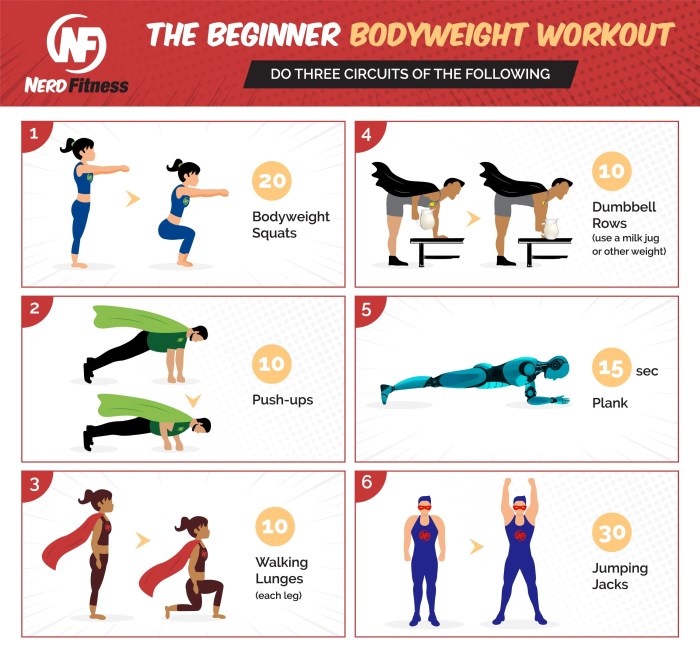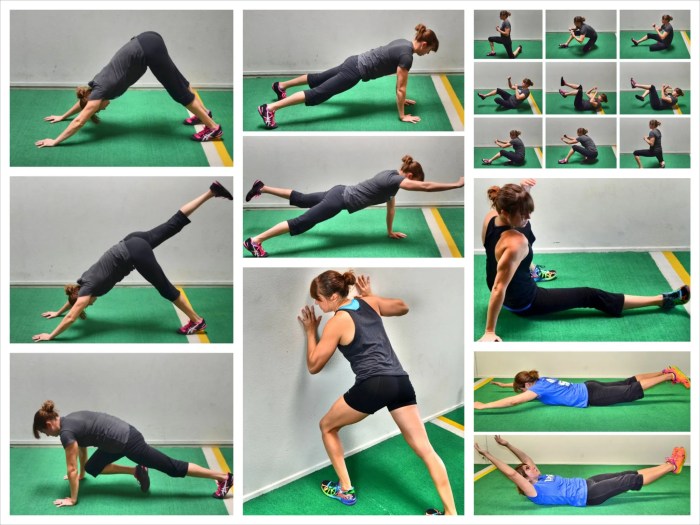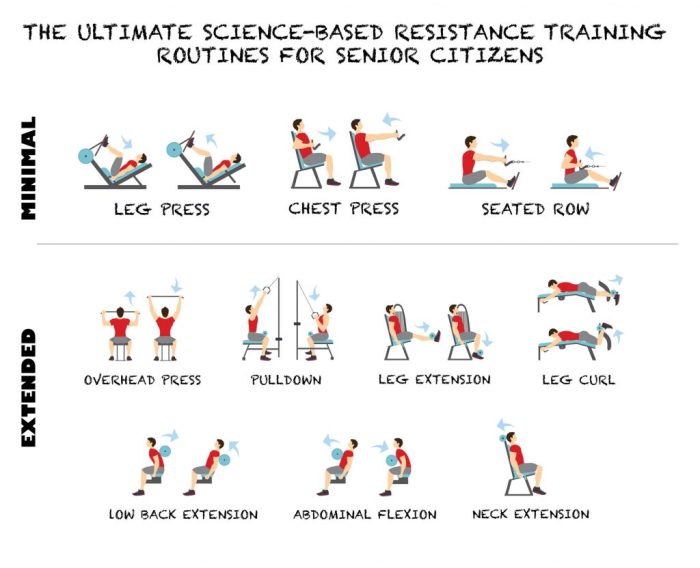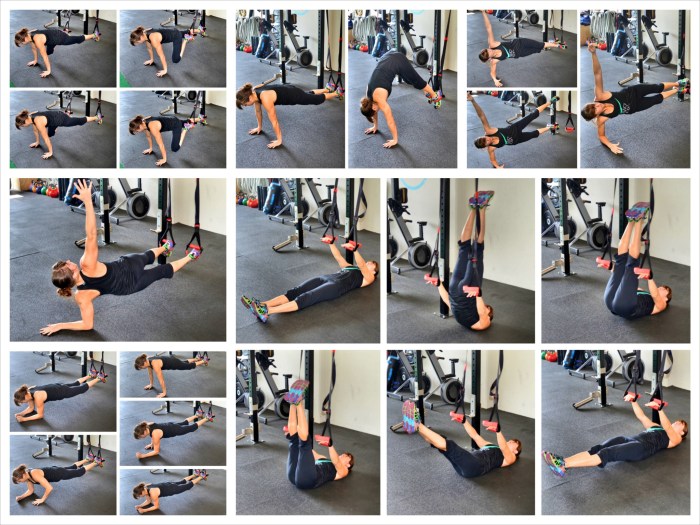Strength training activities, encompassing a wide spectrum of exercises, are the cornerstone of physical fitness. This comprehensive guide delves into the various types of strength training activities, their benefits, risks, and essential guidelines to help you embark on a journey of strength building.
From weightlifting to calisthenics and resistance band exercises, strength training offers a plethora of options to suit different fitness levels and goals. Understanding the nuances of each type of activity empowers you to tailor your training program for optimal results.
Types of Strength Training Activities

Strength training is a type of exercise that involves using resistance to build muscle strength and endurance. There are many different types of strength training activities, each with its own benefits and drawbacks.
Weightlifting
Weightlifting is a type of strength training that involves lifting weights to build muscle strength and endurance. Weightlifting can be done with free weights, such as dumbbells and barbells, or with machines. Weightlifting is a very effective way to build muscle, but it can also be dangerous if done incorrectly.
It is important to learn proper lifting technique before starting a weightlifting program.
Calisthenics
Calisthenics is a type of strength training that involves using body weight to build muscle strength and endurance. Calisthenics exercises can be done anywhere, and they do not require any special equipment. Calisthenics is a great way to build muscle, but it can be challenging for beginners.
Resistance Band Exercises
Resistance band exercises are a type of strength training that involves using resistance bands to build muscle strength and endurance. Resistance bands are a great way to build muscle, and they are also portable and affordable. Resistance band exercises are a good option for beginners, as they are less likely to cause injury than weightlifting.
| Type of Strength Training | Benefits | Drawbacks |
|---|---|---|
| Weightlifting | Builds muscle strength and endurance, improves bone density, reduces risk of chronic diseases | Can be dangerous if done incorrectly, requires proper technique |
| Calisthenics | Builds muscle strength and endurance, improves flexibility, can be done anywhere | Can be challenging for beginners, requires good body awareness |
| Resistance Band Exercises | Builds muscle strength and endurance, portable and affordable, good for beginners | May not be as effective as weightlifting for building muscle, can be difficult to find the right resistance |
Benefits of Strength Training

Strength training, a form of exercise involving the contraction of muscles against resistance, offers a multitude of health benefits. These benefits extend beyond improved physical appearance to encompass various aspects of health and well-being.
The mechanisms underlying the benefits of strength training involve hormonal adaptations and improved neuromuscular function. Resistance exercises stimulate the release of anabolic hormones, such as testosterone and growth hormone, which promote muscle growth and repair. Additionally, strength training enhances neuromuscular function by improving coordination, balance, and the ability to perform everyday tasks.
Improved Muscle Mass
Strength training is a potent stimulus for muscle growth. It promotes the synthesis of muscle proteins, leading to increased muscle mass and strength. This is particularly important for older adults, who naturally lose muscle mass with age. Strength training can help preserve muscle function and independence in this population.
Enhanced Bone Density
Strength training also improves bone density. The mechanical stress placed on bones during resistance exercises stimulates bone cells to increase bone formation and reduce bone loss. This is beneficial for preventing osteoporosis, a condition characterized by weak and brittle bones.
Reduced Risk of Chronic Diseases
Strength training has been linked to a reduced risk of chronic diseases, including heart disease, stroke, type 2 diabetes, and certain types of cancer. The mechanisms underlying these benefits are multifaceted and include improved blood pressure control, reduced inflammation, and enhanced insulin sensitivity.
| Benefit | Specific Adaptations | Health Outcomes |
|---|---|---|
| Improved Muscle Mass | Increased muscle protein synthesis | Preservation of muscle function in older adults |
| Enhanced Bone Density | Increased bone formation | Prevention of osteoporosis |
| Reduced Risk of Chronic Diseases | Improved blood pressure control, reduced inflammation, enhanced insulin sensitivity | Reduced risk of heart disease, stroke, type 2 diabetes, and certain types of cancer |
Progressive Overload
Progressive overload is a fundamental principle in strength training that involves gradually increasing the demands placed on your muscles over time. It’s essential for continuous muscle growth and strength development.
The concept behind progressive overload is that your muscles adapt to the stress you subject them to. By consistently challenging them with slightly heavier weights, more repetitions, or increased intensity, you force them to work harder and become stronger.
Benefits of Progressive Overload
- Increased muscle mass and strength
- Improved bone density
- Enhanced metabolic rate
- Reduced risk of injuries
- Improved athletic performance
To implement progressive overload, you can adjust various training variables such as:
- Weight or resistance
- Volume (sets and repetitions)
- Frequency (number of training sessions per week)
- Intensity (percentage of maximum effort)
It’s important to note that progressive overload should be gradual and tailored to your individual fitness level. Increasing the demands too quickly can lead to overtraining or injuries.
Training Frequency and Intensity
Strength training workouts should be performed at an optimal frequency and intensity to maximize results. The frequency refers to how often you train each muscle group per week, while the intensity refers to the amount of weight or resistance used during exercises.
Training Frequency
* Beginners: 2-3 times per week
Intermediate
3-4 times per week
Advanced
4-5 times per week
Training Intensity
* Beginners: 60-70% of 1RM (one-repetition maximum)
Intermediate
70-85% of 1RM
Advanced
85-100% of 1RM
Sample Workout Plan
Monday:Chest, triceps Tuesday:Rest Wednesday:Back, biceps Thursday:Rest Friday:Legs, shoulders Saturday:Rest Sunday:Active recovery
Warm-Up and Cool-Down
Properly preparing your body for strength training workouts is essential for maximizing results and minimizing the risk of injury. This involves warming up before and cooling down afterward.
Warm-up:Warming up gradually increases your body temperature, heart rate, and blood flow to the muscles. This prepares your muscles for the demands of strength training, improves flexibility, and reduces the risk of muscle strains and tears.
Warm-Up Routine
- Start with 5-10 minutes of light cardio, such as brisk walking or jogging.
- Perform dynamic stretches that involve moving your joints through their full range of motion, such as arm circles, leg swings, and torso twists.
- Gradually increase the intensity and specificity of your warm-up exercises, focusing on movements that mimic the exercises you’ll be performing in your workout.
Cool-down:Cooling down gradually reduces your body temperature, heart rate, and blood flow, helping your body recover from the workout. This can improve flexibility, reduce muscle soreness, and promote relaxation.
Cool-Down Routine
- Perform 5-10 minutes of light cardio, such as walking or cycling.
- Perform static stretches that involve holding each stretch for 15-30 seconds, focusing on the major muscle groups used in your workout.
- Use foam rolling or massage to release muscle tension and improve flexibility.
Proper Form
Proper form is crucial in strength training as it ensures optimal muscle activation, minimizes the risk of injuries, and maximizes the effectiveness of the exercises. Maintaining correct form involves controlling the movement, engaging the right muscles, and executing the exercise with precision.
By adhering to proper form, you can effectively target the intended muscle groups, reduce stress on joints and connective tissues, and improve overall performance. Moreover, it helps you maintain balance and stability, preventing compensations that could lead to muscle imbalances or injuries.
Key Points for Proper Form
- Control the movement throughout the entire range of motion.
- Maintain a neutral spine and avoid arching or rounding your back.
- Keep your core engaged and your hips and shoulders stable.
- Use a weight that challenges you while allowing you to maintain proper form.
- Focus on contracting the target muscle groups and avoid using momentum.
- Involve a qualified trainer or fitness professional to assess your form and provide guidance.
Sample Strength Training Programs
Designing a strength training program that suits your fitness level is crucial. Here are sample programs for beginners, intermediate, and advanced lifters, along with detailed guidance on each.
Beginner-Friendly Strength Training Program
Beginners should start with a program that focuses on proper form and technique. Choose exercises that target all major muscle groups and gradually increase weight or resistance as you progress.
- Barbell Back Squat:Stand with feet shoulder-width apart, lower your body by bending your knees and hips, keeping your back straight.
- Modification:Use a lighter weight or perform bodyweight squats.
- Bench Press:Lie on a bench with feet flat on the floor, lower the barbell to your chest, and press it back up to the starting position.
- Modification:Use dumbbells or resistance bands instead of a barbell.
- Dumbbell Rows:Hold dumbbells in each hand, bend over at the hips, and pull the dumbbells towards your chest.
- Modification:Perform rows with a resistance band attached to a fixed object.
- Overhead Press:Stand with feet shoulder-width apart, hold dumbbells or a barbell overhead, and lower it to shoulder height before pressing it back up.
- Modification:Use lighter weights or perform the exercise without weights.
Sample Workout Plan:Perform 2-3 sets of 10-12 repetitions of each exercise, 2-3 days per week.
Intermediate Strength Training Program
Intermediate lifters can increase the intensity and volume of their training by adding more weight, sets, and repetitions. Introduce advanced exercises and techniques to challenge your muscles further.
- Weighted Lunges:Hold dumbbells or kettlebells in each hand, step forward with one leg and bend both knees.
- Modification:Perform lunges without weights.
- Romanian Deadlifts:Stand with feet hip-width apart, hold a dumbbell or kettlebell in each hand, and hinge at the hips, keeping your back straight.
- Modification:Perform Romanian deadlifts with lighter weights or without weights.
- Pull-Ups:Hang from a pull-up bar, pull yourself up until your chin reaches the bar, and lower yourself back down.
- Modification:Use an assisted pull-up machine or resistance bands for assistance.
- Incline Bench Press:Lie on an incline bench with feet flat on the floor, lower the barbell to your chest, and press it back up to the starting position.
- Modification:Use lighter weights or perform the exercise without weights.
Sample Workout Plan:Perform 3-4 sets of 8-10 repetitions of each exercise, 3-4 days per week.
Advanced Strength Training Program
Advanced lifters should incorporate heavy lifting, plyometrics, and metabolic conditioning into their training. Periodize your program to optimize results and allow for recovery.
- Power Cleans:Stand with feet hip-width apart, hold a barbell on the floor, lift it to shoulder height, and then quickly pull it up to your chest.
- Modification:Perform power cleans with lighter weights or use a resistance band.
- Box Jumps:Stand facing a box, jump onto the box, and step down.
- Modification:Use a lower box or perform step-ups instead of jumps.
- Sprints:Run at maximum speed for a short distance, then rest.
- Modification:Adjust the distance or intensity of the sprints.
Periodization:Divide your training into phases, such as a strength phase, hypertrophy phase, and peaking phase. Each phase should have specific goals and exercises.
Recovery:Allow for adequate rest and recovery between training sessions and incorporate active recovery activities, such as yoga or swimming, to promote muscle recovery.
Nutrition for Strength Training
Nutrition plays a crucial role in supporting the demands of strength training. To optimize your results, it’s essential to consume a balanced diet that provides the necessary nutrients for muscle growth and recovery.
Your daily calorie intake should be tailored to your individual needs, including your activity level, weight, and fitness goals. In general, strength training requires a higher calorie intake compared to other forms of exercise.
Protein
- Protein is essential for building and repairing muscle tissue. Aim for 1.6-2.2 grams of protein per kilogram of body weight per day.
- Good sources of protein include lean meats, poultry, fish, eggs, dairy products, beans, and lentils.
Carbohydrates
- Carbohydrates provide energy for your workouts. Choose complex carbohydrates such as whole grains, fruits, and vegetables.
- Aim for 4-6 grams of carbohydrates per kilogram of body weight per day.
Fats
- Healthy fats support hormone production and cell function. Include sources such as olive oil, avocado, nuts, and seeds in your diet.
- Aim for 1-1.2 grams of fat per kilogram of body weight per day.
Hydration
- Stay adequately hydrated by drinking plenty of water throughout the day, especially before, during, and after workouts.
- Dehydration can impair performance and recovery.
Timing of Meals
- Consume a meal rich in carbohydrates and protein within 2 hours after your workout to optimize muscle recovery.
- Spread your protein intake evenly throughout the day to support muscle synthesis.
Safety Considerations
Strength training is a highly effective way to improve your overall health and fitness, but it’s important to be aware of the potential risks involved and to take steps to minimize them.
One of the most important safety considerations is to use proper form when performing exercises. Incorrect form can put unnecessary stress on your joints and muscles, which can lead to injuries. It’s important to learn the correct form for each exercise from a qualified personal trainer or fitness professional.
Warm-up and Cool-down
Warming up before strength training is essential to prepare your body for the demands of exercise. A proper warm-up will help to increase your heart rate, loosen your muscles, and improve your range of motion. This will help to reduce your risk of injuries.
Cooling down after strength training is also important to help your body recover from the workout. A cool-down will help to lower your heart rate, stretch your muscles, and reduce your risk of muscle soreness.
Overexertion, Strength training activities
One of the most common mistakes that people make when strength training is to try to do too much too soon. This can lead to overexertion, which can cause injuries. It’s important to start slowly and gradually increase the intensity and duration of your workouts over time.
Listen to Your Body
It’s important to listen to your body when strength training. If you feel pain, stop the exercise and consult with a medical professional. Pushing through pain can lead to serious injuries.
Equipment for Strength Training
Strength training equipment varies in its design, functionality, and the type of exercises it supports. Choosing the right equipment depends on individual fitness goals, experience level, and available space. Let’s explore the common types of strength training equipment:
Barbells
Barbells are long, straight bars with weighted plates attached at each end. They are versatile and allow for a wide range of exercises, including squats, deadlifts, bench presses, and overhead presses. Barbell training can be highly effective for building strength and muscle mass.
Dumbbells
Dumbbells are individual weights with handles. They are ideal for unilateral exercises, where each arm or leg moves independently. Dumbbells provide greater flexibility and range of motion compared to barbells, making them suitable for various exercises like bicep curls, tricep extensions, and lunges.
Machines
Strength training machines are designed to isolate specific muscle groups and provide a controlled movement path. They offer a safe and effective way to target specific areas, reduce the risk of injury, and accommodate individuals with limited mobility or injuries.
Examples include leg press machines, chest press machines, and lat pulldown machines.
| Equipment | Advantages | Disadvantages |
|---|---|---|
| Barbells | Versatile, compound exercises, high weight capacity | Requires a spotter, can be challenging for beginners |
| Dumbbells | Unilateral exercises, greater range of motion | Limited weight capacity, requires more space |
| Machines | Safe, isolated exercises, accommodates injuries | Limited range of motion, can be less challenging |
The choice of equipment depends on individual needs and preferences. A combination of different equipment types can provide a well-rounded strength training program that targets various muscle groups and movement patterns.
Myths and Misconceptions about Strength Training

Strength training is a valuable form of exercise that offers numerous benefits. However, it is surrounded by several myths and misconceptions that can deter people from engaging in it. This section aims to debunk these myths and provide evidence-based information to clarify the truth about strength training.
Here are some of the most common myths and misconceptions about strength training:
- Myth:Strength training is only for men.
- Fact:Strength training is beneficial for both men and women. It helps build muscle, improve bone density, and enhance overall fitness.
- Myth:Strength training will make me bulky.
- Fact:While strength training can increase muscle mass, it is unlikely to make you bulky unless you are specifically training for that goal. Women, in particular, have lower levels of testosterone, which makes it more challenging to build excessive muscle mass.
- Myth:Strength training is dangerous.
- Fact:Strength training is generally safe when performed correctly. However, it is important to start gradually and use proper form to minimize the risk of injury.
- Myth:Strength training is only for young people.
- Fact:Strength training is beneficial for people of all ages. It helps maintain muscle mass, improve balance, and reduce the risk of falls in older adults.
- Myth:Strength training requires a lot of equipment.
- Fact:Strength training can be done with minimal equipment, such as bodyweight exercises, dumbbells, or resistance bands.
| Myth | Fact |
|---|---|
| Strength training is only for men. | Strength training is beneficial for both men and women. |
| Strength training will make me bulky. | Strength training can increase muscle mass, but it is unlikely to make you bulky unless you are specifically training for that goal. |
| Strength training is dangerous. | Strength training is generally safe when performed correctly. |
| Strength training is only for young people. | Strength training is beneficial for people of all ages. |
| Strength training requires a lot of equipment. | Strength training can be done with minimal equipment, such as bodyweight exercises, dumbbells, or resistance bands. |
Strength Training for Different Goals

Tailoring strength training programs to specific goals is crucial for maximizing results. Whether you aim to build muscle, lose weight, or enhance athletic performance, adjusting your workouts accordingly is essential.
Building Muscle
- Progressive Overload:Gradually increase weight, sets, or reps over time to challenge muscles and promote growth.
- Compound Exercises:Focus on exercises that work multiple muscle groups simultaneously, such as squats, deadlifts, and bench press.
- Rest Periods:Allow sufficient rest between sets (1-2 minutes) to recover and prevent muscle fatigue.
- High-Intensity:Lift weights that are challenging but allow for proper form.
- Adequate Protein Intake:Consume 1.6-2.2 grams of protein per kilogram of body weight daily to support muscle repair and growth.
Losing Weight
- Circuit Training:Alternate between exercises with minimal rest to elevate heart rate and burn calories.
- Bodyweight Exercises:Utilize exercises like push-ups, squats, and lunges to engage multiple muscle groups and boost calorie expenditure.
- Cardiovascular Activity:Incorporate aerobic exercises like running, cycling, or swimming to further increase calorie burn.
- Reduced Rest Periods:Keep rest periods short (30-60 seconds) to maintain an elevated heart rate and maximize calorie expenditure.
- Calorie Deficit:Consume fewer calories than you burn to create a calorie deficit necessary for weight loss.
Improving Athletic Performance
- Sport-Specific Exercises:Include exercises that mimic the movements and demands of your chosen sport.
- Explosive Movements:Incorporate exercises like plyometrics and jump training to improve power and explosiveness.
- Speed Training:Focus on exercises that enhance speed and agility, such as sprints and agility drills.
- Periodization:Divide your training into phases with varying intensity and volume to optimize performance and prevent plateaus.
- Proper Recovery:Allow for sufficient rest and recovery to ensure optimal performance during training sessions.
| Goal | Exercises | Rest Periods | Intensity |
|---|---|---|---|
| Building Muscle | Compound exercises | 1-2 minutes | High |
| Losing Weight | Circuit training, bodyweight exercises | 30-60 seconds | Moderate-high |
| Improving Athletic Performance | Sport-specific exercises, explosive movements | Varies depending on exercise | Varies depending on exercise |
Final Summary

Strength training activities are a potent tool for transforming your physical well-being. By embracing the principles Artikeld in this guide, you can unlock the benefits of increased muscle mass, enhanced bone density, and reduced risk of chronic diseases. Remember, consistency, proper form, and a balanced approach are key to maximizing the transformative power of strength training.
Answers to Common Questions
What are the different types of strength training activities?
Strength training activities encompass a wide range, including weightlifting, calisthenics, resistance band exercises, and bodyweight training.
What are the benefits of strength training?
Strength training offers numerous benefits, including increased muscle mass, enhanced bone density, improved metabolism, and reduced risk of chronic diseases.
How do I get started with strength training?
Begin by choosing exercises that suit your fitness level, setting realistic goals, and finding a workout buddy for support and motivation.
Leave a Reply